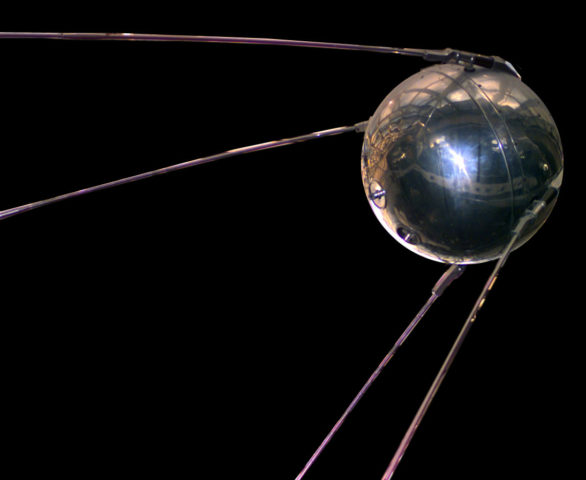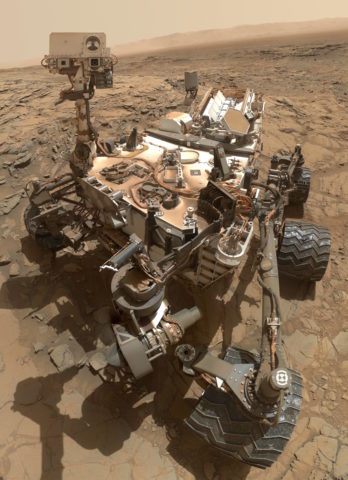Why Does Earth Have a Moon?
Astronomer Denilso Camargo on the origin of the Moon, its interaction with the Sun and Earth, and formation pr...

Space electronics is a distinct field within electronic research, born out of the need to explore space. As humanity ventured into the cosmos, scientists required technologies capable of withstanding the harsh conditions of space to collect, store, process, and transmit data. Engineers have developed increasingly sophisticated satellites—spacecraft that orbit Earth to meet these challenges. These devices help astrophysicists study the universe, search for exoplanets, and observe distant celestial objects.
Over the years, many technological solutions used in space electronics have been adapted from terrestrial developments. From the mid-20th century to today, the evolution of space devices has closely followed advancements in ground-based electronics.
The first space exploration projects were built on an electronic component base initially developed for military purposes. These early developments were often classified, and as a result, many details about military satellites and the names of their inventors remain unknown. Soviet engineers launched the first spacecraft under the leadership of Sergei Korolev. This was Sputnik 1, which entered orbit in 1957. Its internal structure was simple—Sputnik 1 had no orientation system and rotated randomly in space.
Additionally, it could not receive signals from Earth. Its sole function was to measure the spacecraft’s internal temperature and pressure and transmit that data back to Earth. Remarkably, its two transmitters had a combined output of about 1 watt—quite powerful for the time. Anyone with a radio receiver could tune in and hear the signals from Sputnik 1.

The second Soviet spacecraft, Sputnik 2, was launched on November 3, 1957. Unlike its predecessor, this mission had specific scientific goals: to collect data on solar ultraviolet radiation and cosmic rays. This program was overseen by physicists Sergei Mandelstam and Sergei Vernov. In 1959, Soviet scientists launched the Luna 3 station, which, thanks to a photo television system, captured and transmitted the first images of the far side of the Moon.
Spacecraft development began long before the digital electronics era. Early devices were built using analogue vacuum tubes. A cathode and an anode are inside a vacuum tube, with a grid placed between them. The cathode is negatively charged, and the anode is positively charged, causing electrons to flow to the anode, thus allowing current to pass. By applying additional voltage to the grid, one could control the flow of electrons, either blocking or enabling the current. By connecting vacuum tubes in circuits and adjusting the voltage between them, they could process binary information, where the presence of current represented a “1” and the absence represented a “0.” These components could perform basic logical operations with these 1s and 0s, like addition or multiplication. From these logical elements, primitive memory devices, known as flip-flops, were constructed. Flip-flops, in turn, were used to build adders and memory cells. However, devices built using vacuum tubes were so bulky that they could quickly fill an entire school gymnasium.
In the mid-20th century, engineers transitioned from vacuum tubes to transistors, which were much smaller and roughly a thousand times more efficient. Like vacuum tubes, transistors also controlled currents, but their operation relied on semiconductor effects. Engineers could combine transistors into integrated circuits that could be programmed. By 1976, Soviet space missions had fully adopted integrated circuits, marking the shift to digital electronics in the country’s space program.
The instruments aboard the first satellites were housed in sealed containers filled with air at room temperature. These precautions were necessary because the instruments had to function in extreme temperatures, the vacuum of space, and increased radiation levels. Moreover, any device intended for space use must withstand the vibrations and high G-forces during a rocket launch. Standard terrestrial technologies often fail in such conditions. One of the key challenges in space electronics has always been to find engineering solutions that make digital devices resilient to these harsh environments.
One of the most significant challenges for engineers is protecting devices from radiation, which is much more intense in space than on Earth. Earth’s magnetic field shields us from solar wind and other low-energy particles, primarily protons and electrons. As a result, radiation does not reach Earth’s surface but accumulates around it, forming radiation belts. Electrons and protons become trapped in magnetic field lines, oscillating between the North and South Poles, creating these belts. During solar storms, the radiation belts can dip into the atmosphere, causing the northern lights to appear in polar regions.
Soviet scientists were the first to observe radiation in space when they analyzed data from *Sputnik 2* in 1957. In 1958, American astrophysicist James Van Allen further described the radiation belts using U.S. satellite *Explorer 1*data.
Cosmic rays contain particles from almost every type of atomic nucleus. Depending on their energy, these particles vary in their ability to penetrate materials. The most dangerous particles are the nuclei of heavy elements, such as iron or lead.
The density, composition, and threat level of radiation belts depend on the spacecraft’s altitude. Reliability requirements for devices differ based on the orbit they operate in. The most benign conditions are found in low Earth orbit (LEO), which ranges from 160 to 2,000 kilometres above Earth and does not pass over the poles. The International Space Station (ISS) is located in LEO, where astronauts live for months, using laptops and smartphones without issue. In LEO, electronics made from standard microchips, like STM microcontrollers commonly used in terrestrial robotics, can operate reliably.
Radiation levels are significantly higher at 20,000 kilometres above Earth, where GLONASS and GPS satellites orbit. The penetrating power of charged particles at these altitudes makes it impossible to use terrestrial microchips for satellites. Therefore, space-bound electronics at these orbits require much more robust protection and specialized components to survive the harsh radiation environment.
Preparing electronics for extreme radiation environments begins at the semiconductor level in microchips and circuits. Engineers modify these technologies, expecting the electronics to interact with radiation and be exposed to ionizing radiation. Devices need to be resistant to high cumulative radiation doses. The annual cumulative radiation dose on Earth’s surface is about 1 krad. Still, on the International Space Station (ISS), it’s already 2 krad, and within the radiation belts, it can reach up to 100 krad.
One of the key strategies for protecting devices from radiation involves improving the architecture of electronic circuits. A failure in a single component must not lead to losing the entire spacecraft. To prevent this, designers focus on building redundancy for critical systems. This approach allows satellites to carry spare batteries, additional transmitters, or a second onboard bus to ensure communication between the onboard computer and all system components. From an architectural standpoint, a notable example is the recent launch of the Planet Hunters TESS mission, a satellite designed to search for exoplanets from a highly elliptical orbit. TESS is built with radiation-vulnerable chips, but its vital systems are duplicated for protection. The mission’s designers have also limited its operational lifespan to two years to mitigate radiation exposure.
The future of space technology depends heavily on the development of radiation-resistant microchips. Scientists are continually searching for better solutions to meet this challenge. Various microchips are used in electronics, including microcontrollers, processors, FPGAs (field-programmable gate arrays), memory chips, and more. These components have varying degrees of resilience to radiation, with memory chips—both RAM and non-volatile memory—being the most difficult to protect. This is because most modern memory chips store information (1s and 0s) as an electrical charge, which is particularly vulnerable to disruption by ionizing radiation.
In recent years, the electronics industry has made significant strides in producing radiation-hardened microcontrollers. A microcontroller is a chip that runs programs written in languages like C (or sometimes assembly language). In a spacecraft’s onboard computer, the microcontroller processes commands and manages other chips. For example, it monitors electrical currents and temporarily shuts down systems if a sudden voltage spike occurs—another safeguard against radiation damage. The device can avoid permanent failure by cutting power immediately after a charged particle strikes. In addition to managing other chips, the microcontroller collects data from them and stores it in memory. It can also communicate with a transceiver that sends sensor data back to ground stations, allowing engineers to monitor critical parameters like the spacecraft’s temperature. Domestic and international manufacturers have achieved impressive levels of radiation-resistant microcontroller production, with performance reaching the ARM Cortex M4F / M7 level. The gap between space microcontrollers and their terrestrial counterparts is only a few years.
However, there are limits to how much processing power can be packed into a microcontroller. As developers push the boundaries, they often find the microcontroller’s internal memory inadequate for the growing complexity of tasks. In such cases, a microcontroller can be replaced with a processor, which offers higher performance. Additional external chips take over certain functions, such as storing programs in memory. A complete computer system is built with these supporting chips and the processor. However, making processors radiation-resistant is far more complicated than protecting microcontrollers, and only a few examples have been successful. One such example is the American radiation-hardened computer RAD750, a legendary space device that has repeatedly proven its reliability and effectiveness. However, using the RAD750 is prohibitively expensive, running into hundreds of thousands of dollars, whereas modern radiation-resistant microcontrollers cost between $3,000 and $10,000.
Radiation-resistant FPGAs have also been successfully developed. Unlike microcontrollers and processors, where actions are programmed step by step in sequence, FPGAs are programmed by describing the chip’s internal structure, allowing multiple lines of code to run in parallel. This flexibility makes FPGAs popular with developers, as they can be configured in various ways. However, this flexibility comes at the cost of increased power consumption, higher prices, and lower computing power. When an effective configuration for a specific task is found, it is possible to mass-produce identical chips to solve that task in particular devices. These chips are known as ASICs (application-specific integrated circuits). ASICs are designed to perform a single function and cannot be reprogrammed, but their mass production significantly reduces costs.
The development of space technology has closely mirrored the evolution of terrestrial electronics. Seventy years ago, a rocket could carry only one satellite, but today, we can launch up to a hundred at a time. This is thanks to Moore’s Law and Dennard scaling — fundamental principles that have driven the progress of the electronics industry. These laws allow us to increase the performance of devices by packing more logic gates into microchips while simultaneously reducing their size. Using these same principles, we can now build miniature satellites known as CubeSats—10x10x10 cm cubes. CubeSats are structured similarly to larger spacecraft, with comparable life-support systems and space orientation mechanisms, using technologies like magnetic coils or reaction wheels.
CubeSats may be less functional than larger satellites. Still, their key advantage is their low launch cost, making it possible for universities and even schools to send their satellites into space. This is vital for training the next generation of space professionals, as educational institutions can give young people hands-on experience with satellite technology early in their careers. Beyond education, CubeSats offers an affordable platform to test innovative ideas that would be too expensive to test on larger spacecraft. Researchers use CubeSats to experiment with laser communication, conduct microgravity experiments, and study gamma-ray bursts and space weather.
CubeSats also provide a bridge between space exploration and advancements in the Internet of Things (IoT)—a field currently being explored by numerous Western and Australian startups, with China also playing an active role. The essence of IoT technology is that sensors in various devices transmit data to base stations, which can then be accessed via the Internet. A CubeSat in space can collect data directly from these sensors. While this technology is still in the testing phase, some technological hurdles can be overcome. Engineers have yet to create a satellite that can fully adapt to IoT network standards and seamlessly communicate with existing sensors.
While neural networks, artificial intelligence (AI), and robotics have reached widespread use in terrestrial electronics, their peak popularity may have passed. The next big trend will be integrating AI into space electronics, with the potential to reduce reliance on Earth-based control in the future.
One obvious application of AI in spacecraft is data processing, such as searching for exoplanets. However, a far more exciting and promising use case is robotics. Currently, space rovers move very slowly because every step they take is controlled from Earth. For example, the Mars rover *Curiosity* has covered only 18 kilometres in six years—a distance that an autonomous car on Earth could travel in 20 to 30 minutes. The autonomous driving technologies developed today will likely be applied to space rovers and space stations within the next 10 to 20 years. If we can train rovers to navigate terrain independently or even move autonomously, they will gather significantly more data for scientists. In the long run, this could be more efficient than sending humans into space.

Space-based autonomous technologies are unlikely to run on conventional processors. First, it’s challenging to make processors radiation-resistant. Second, neural networks perform poorly on processors. Like the human brain, neural networks are structured so multiple neurons work in parallel. A single-core processor can only execute one operation at a time, meaning that it would have to sequentially calculate signals for each neuron, process the information, and then draw conclusions—a time-consuming process. Autonomous space rovers will need new chips—likely FPGAs or ASICs. These can be made radiation-resistant, enabling engineers to successfully transfer terrestrial technologies into space applications.

Astronomer Denilso Camargo on the origin of the Moon, its interaction with the Sun and Earth, and formation pr...

Physicist David Southwood on the exploration of the oceans, Earth meteorology and how can we observe climate c...

How is electricity transmitted, and could we transition to wireless power?